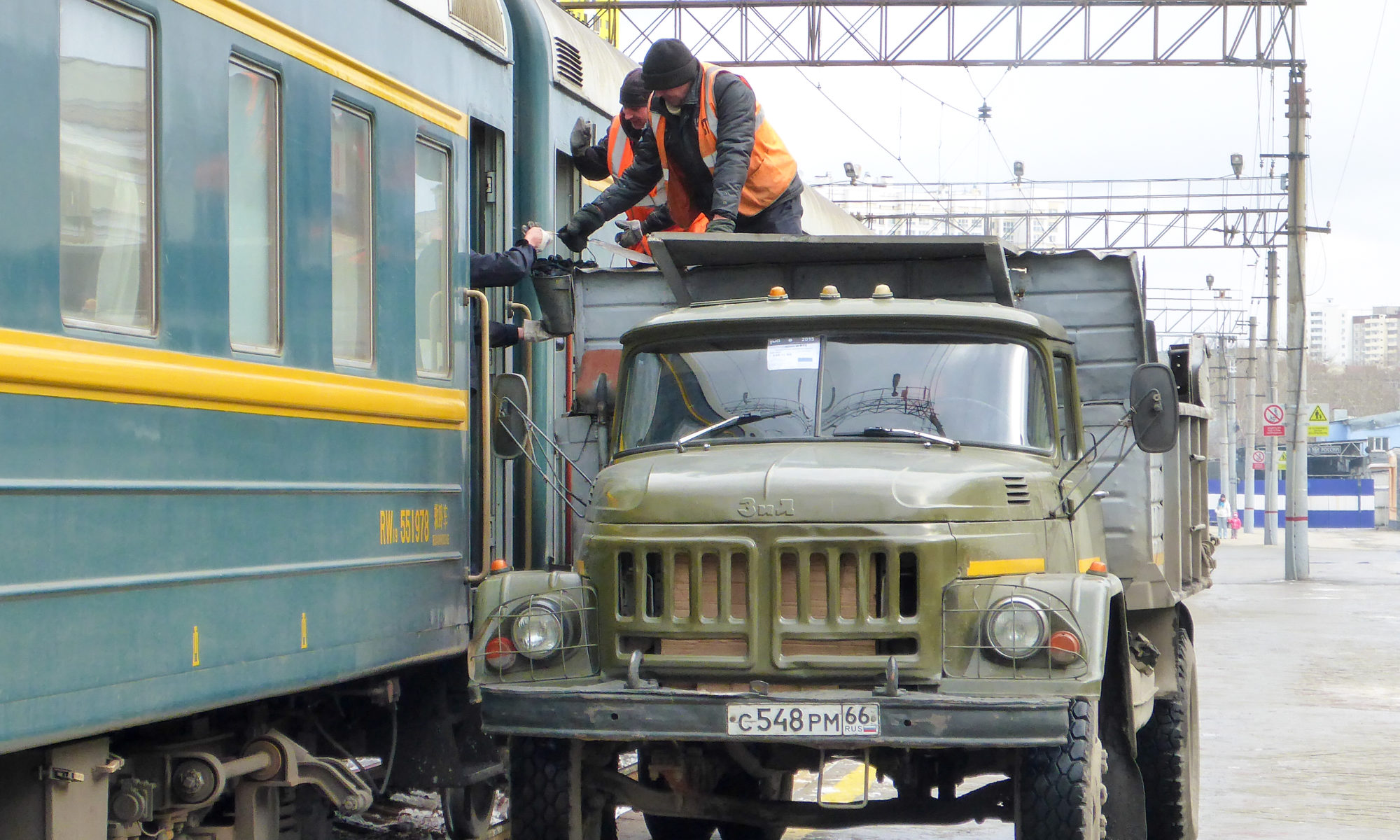Lucky doesn’t even begin to describe it. I got an e-mail around 4am in Seattle (I think) telling me about a bosun’s mate vacancy on the tall ship Tenacious for the 6 week voyage across the Southern Ocean, around the infamous Cape Horn. I’d like to say I played it cool, equivocated a bit, made the JST work for it. That I sat on it for a day or two to think it over, not seem over-eager or desperate.
Of course that’s a dirty lie. I claimed the spot before my eyes were fully open, jamming words into my phone like I was on 2% battery and ordering a pizza from the last shop open in town.
I got myself to Auckland, New Zealand in time to meet the ship. We had a bit of time for maintenance before the voyage crew joined, so I got to do a bunch of new stuff, like working on the anchors. Oh god, the anchors.

They both needed to come out, entirely, along with all 8 shackles of chain, each. A shackle is a unit of length of anchor chain, universal in the maritime world: 27.432 meters. That’s a weird number right? Except it didn’t used to be: a shackle is actually defined as 15 fathoms, which is 90 feet, which is 27.432 meters. Sailors are nothing if not traditional. For example, they’re still called “sailors” even when the ship they work on has rotating underwater jets for propulsion.
Anyway, anchor chain is heavy. That’s the point, one might say. We hold the ship in place not with the hook on the end, but the weight of the chain we lay out (relative to the depth of the water) that is kept from sliding by the hook. While we were still alongside the pier in Auckland, we dropped the anchors and all 8 shackles of chain each one by one onto a barge and brought them over to a shipyard to do some surgery.

What surgery? Replacing the last 2 shackles of chain on one anchor, and the last 3 on the other. We had to cut off the joining (kenter) shackles at the severing joint, and then join new ones to the new sections. The procedure is complicated but we figured it out, at one point hammering lead into a pin hole to seal it from salt water incursion and keep the pin from escaping.
What job at sea is complete without a coat of paint? We paint the shackle joints as an indicator of which joint it is. The kenter shackle is red, and a certain number equal to the joint index of chain links on either side are painted white. This way as the anchor chain flies by we can keep track of how much is down.
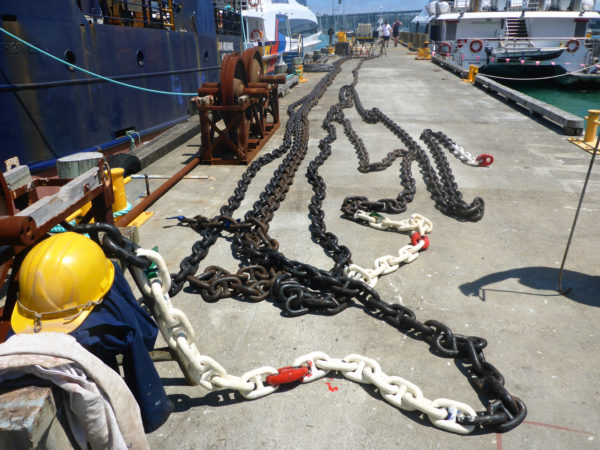
While the paint was drying on the anchor chains, the bosun and officers were directing the setup of an experimental stay from the stem to the bowsprit to help balance the forces pulling it up. They designed a metal plate and then used a magnetic drill to cut through the bracket along the stem to mount it. Lloyds, the insurer, had a look at that with all the other stuff they were inspecting and we were good to go! Once we fixed everything else that broke, anyway.
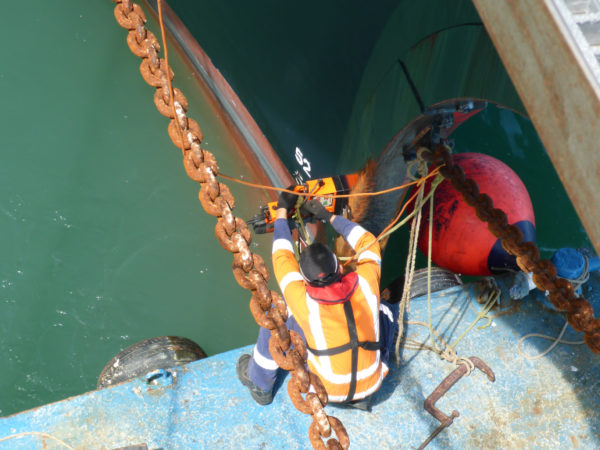
It wasn’t just stuff near the water that needed fixing. Wes had to go up to shift the outer jib to a running halyard so we could bring it down to deck and repair/replace it. This is much easier to do alongside with a giant wind-break of a building next to us.
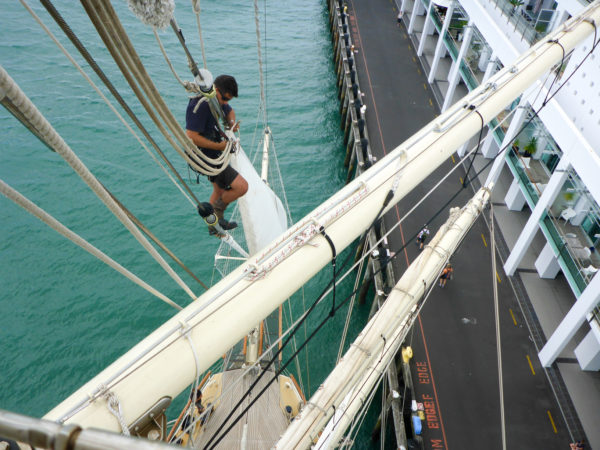
At this point, the anchor chain barge is back and the anchors have to go back in for Lloyds to examine and certify the next day. All that chain has to be pulled back in with a powerful hydraulic windlass, and on the JST ships, it gets stowed by hand by the bosun’s mates. There’s only room for one at a tine in the little hatches into the chain locker, but there’s always a second with a radio for safety and to swap in once the first gets tired. Stowing 1 shackle yourself is hard work. 3 is exhausting. The most I’ve had to do was 5 shackles between two of us. Well, the most I previously had to do… today, we got to do all 16 shackles.
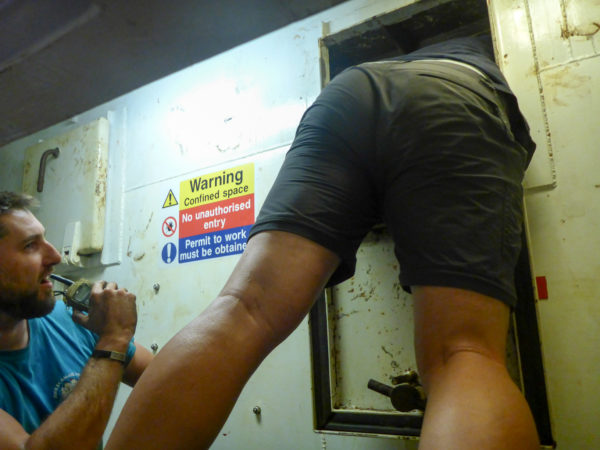
Oh, and the next morning? Lloyds had us drop one anchor fully to prove the work was done and done correctly. Guess who got to stow 8 shackles again.
Still, this time before the voyage crew joined wasn’t all back-breaking labor! But really, mostly it was.
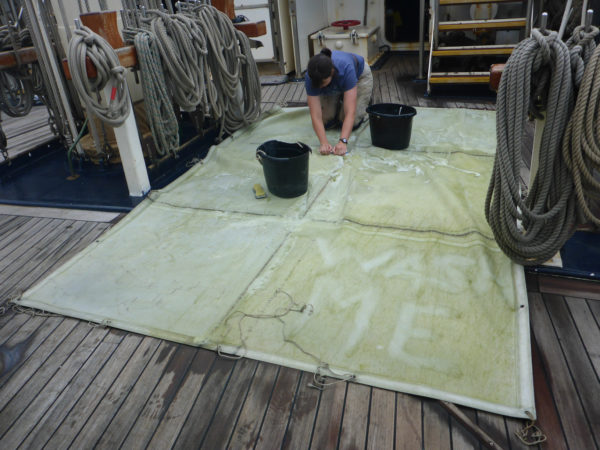
While we were alongside in Auckland, around when the voyage crew arrived, we had a bit of a problem with the alternator on the port diesel generator. We had to pull it out in components, send it away for repair, then reinstall it whole. This required taking the “soft patch” out of the main deck to winch it down into the engine room. In the meantime, the freezer plant quietly died (“I have your fooooood”) and we had to unload all of our frozen and cold stores to go into a freezer container ashore while we got that fixed. It’s a damn good thing this all went wrong while we were alongside — if it had been 2 weeks later, we’d have been in the middle of the ocean with some very difficult decisions to make.

Finally, we left! 10 days late. Now we only had a bit under 5 weeks to get to the Falklands, instead of a full 6. To meet the strict criteria for the Cape Horn association, we needed to round with at least a voyage of 3,000 nm entirely under sail, north of 50 degrees south on both sides of South America. That’s a long long time to not use the engines at all, and our margin to drift in doldrums or go around rough weather had completely disappeared.
Fast forwarding a bit, we were out to sea for 5 weeks straight. In the middle, we passed Point Nemo (twice due to weather). Point Nemo is the Oceanic Pole of Inaccessibility, the farthest point on earth from any land. It’s 2,688 km (1,670 mi) from the Pitcairn Islands in the north, the Easter Islands in the northeast, and one of the islands of Antarctica in the south. We got within 5 nm of it on the second pass. There should be a sailing tattoo for that.
It’s impossible to prove either way, but given how far our sailing ship went outside normal shipping lanes, and the dearth of marine traffic in the Southern Ocean thanks to the Panama Canal, it’s quite possible and maybe even likely that at some point in that 5 weeks the nearest human beings to us were on the International Space Station. It’s roughly 220 miles up, and orbits 15 or so times a day at a sharp diagonal to the equator. We can only “see” about 30nm in any direction with our radars, so we’ll never know, but reasonable people can argue it either way and it makes a cool anecdote.
However, there wasn’t a single day where the ship wasn’t being circled by at least one albatross. These giant birds rarely flap their wings, coasting in ground effect over the surface of the waves.
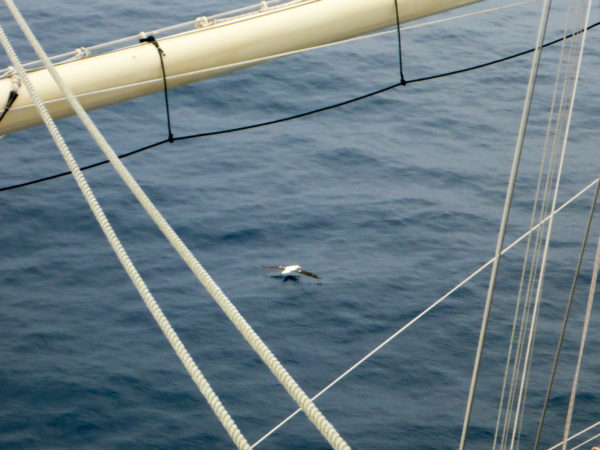
We saw some wind, though! We had as much as a force 11 at one point (for comparison, force 12 is a hurricane), though mostly it was much more pleasant. We did have some damaged sails — we took down 4 or 5 and repaired at least 1 in place. We didn’t have enough diesel to motor to land if all our sails were damaged, and we didn’t have *that* many spares, so our job was clear.
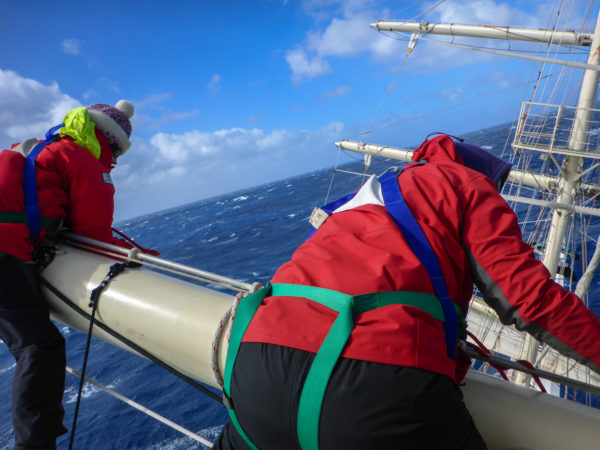
We spent a lot of time aloft taking down damaged sails and putting up repaired ones or spares. We go up in any weather and use gantlines, utility lines on both sides of each mast, to lower and haul up sails. I happened to have a reasonably new GoPro on my head, one with a built-in accelerometer, when Katie and I were sent up to re-lead a gantline back aft, its usual storage place, following a repair to the main topgallant. I found out you can show the lateral G-forces the camera experienced overlaid on the footage. I wasn’t surprised at all to see that the rolling, bounding ship subjected us momentarily to upwards of 3 Gs. I was about 13 stories up, at the tail of the whip, standing with one foot on a rope and the other wrapped around a stay, working with both hands to re-route a line. It’s hard work, but with the right technique it’s actually pretty fun.
The bosun and his mates were busy fixing and building things all over the ship. Like a wicket for a small Australia vs UK cricket game on the main deck.
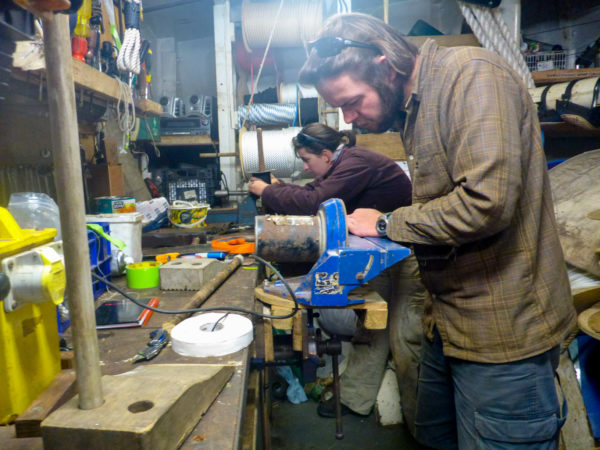
Sometimes we were aloft stitching a seizing into a lashing inside the foil of an in-boom furling topsail. To be honest, I preferred the climbing jobs.
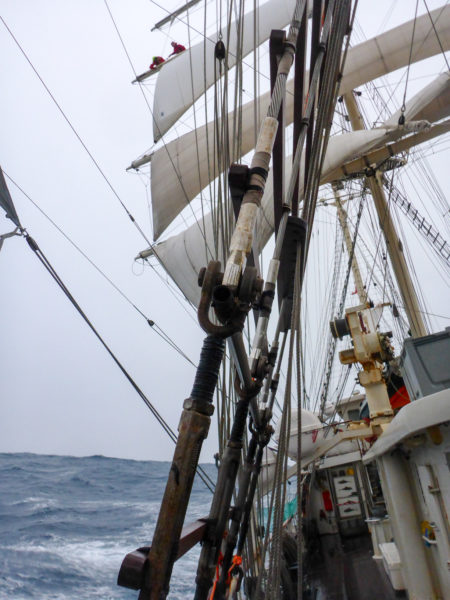
But the view is great! Sometimes you get to watch the voyage crew cleaning the ship, at least when it’s not your turn to run it.
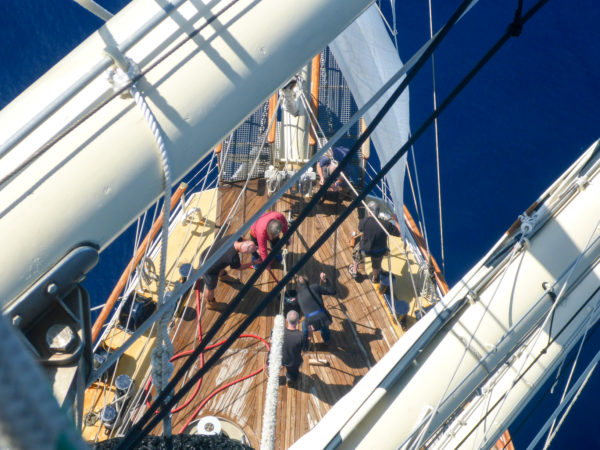
Why scrub the deck? Because of all the salt water we get on it. And spilled coffee and tea.
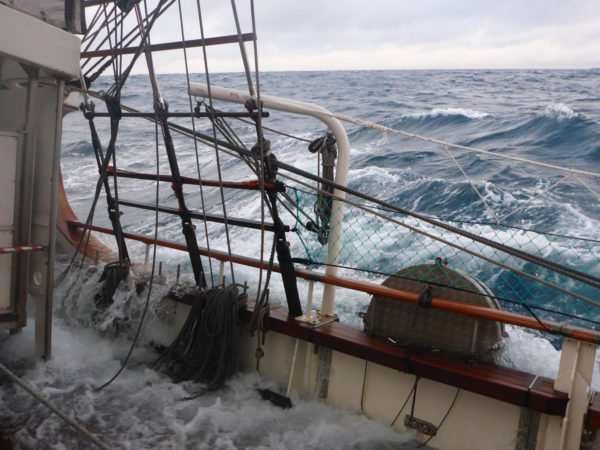
Finally, we made it: Cape Horn. And it was dead calm. We drifted by, took our photos, and turned northeast for the Falklands.
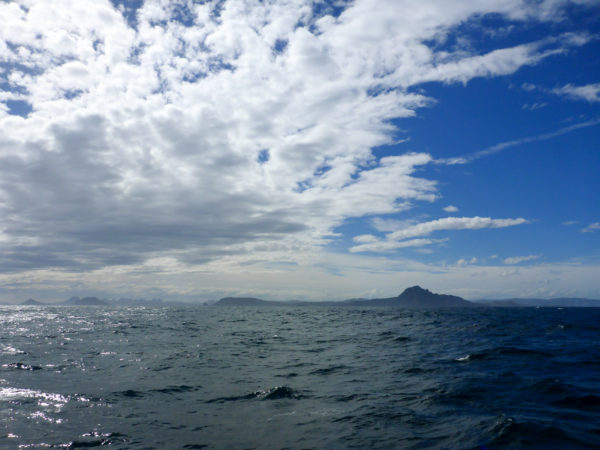
Cape Horn is feared among sailors because of the ferocity of the vast ocean on either side at that latitude and the strong weather patterns that tend to collide there. But even hurricanes have an eye, and we were “fortunate” with our timing past the cape.
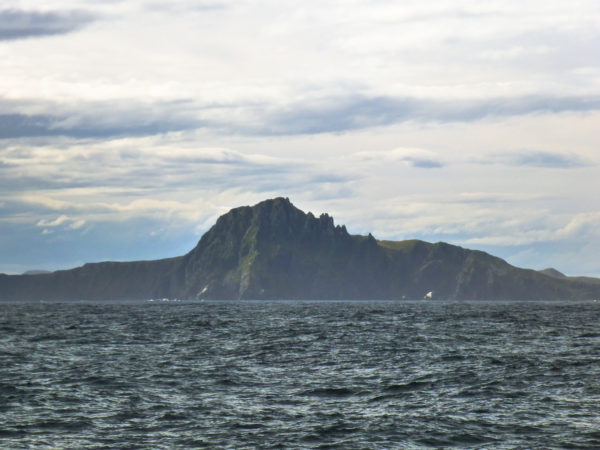
Next time: the Falkland Islands!
